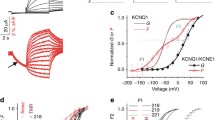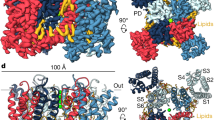Abstract
The voltage-gated potassium channels KV7.2 and KV7.3 (KCNQ2/3 genes) play an important role in regulating neuronal excitability. More than 50 KCNQ2/3 mutations have been identified to cause an inherited form of epilepsy in newborns. For two of those (E119G and S122L) found in the S1–S2 region of KV7.2, we previously showed a decreased channel availability mainly at action potential subthreshold voltages caused by a slight depolarizing shift of the activation curve. Interestingly, recent studies revealed that a threonine residue within the S1–S2 loop, highly conserved among different classes of KV channels, is crucial for both their function and surface expression. To investigate the functional role of the homologous threonine residues in KV7.2 (T114) and KV7.3 (T144) channels, we replaced them with alanine and examined the electrophysiological properties using heterologous expression in CHO cells and whole cell patch clamping. Channels comprising mutant subunits yielded decreased potassium currents with slowed activation and accelerated deactivation kinetics. However, the most striking effect was a depolarizing shift in the voltage dependence of activation reaching +30 mV upon co-expression of both mutant subunits. Potential interactions of T114 within the channel were analyzed by creating a 3D homology model of KV7.2 in an open state suggesting that this residue plays a central role in the formation of a stable interface between the S1–S2 and the S5 segment helices. This could be the explanation why substitution of the conserved threonine in KV7.2 and KV7.3 channels destabilizes the open and favors the closed state of these channels.




Similar content being viewed by others
References
Altschul SF, Madden TL, Schaffer AA, Zhang J, Zhang Z, Miller W, Lipman DJ (1997) Gapped BLAST and PSI-BLAST: a new generation of protein database search programs. Nucleic Acids Res 25:3389–3402
Brown DA, Adams PR (1980) Muscarinic suppression of a novel voltage-sensitive K+ current in a vertebrate neurone. Nature 283:673–676
Brown DA, Passmore GM (2009) Neural KCNQ (Kv7) channels. Br J Pharmacol 156:1185–1195. doi:10.1111/j.1476-5381.2009.00111.x
Canutescu AA, Shelenkov AA, Dunbrack RL Jr (2003) A graph-theory algorithm for rapid protein side-chain prediction. Protein Sci 12:2001–2014. doi:10.1110/ps.03154503
Chen X, Wang Q, Ni F, Ma J (2010) Structure of the full-length Shaker potassium channel Kv1.2 by normal-mode-based X-ray crystallographic refinement. Proc Natl Acad Sci U S A 107:11352–11357
Gomez-Posada JC, Etxeberria A, Roura-Ferrer M, Areso P, Masin M, Murrell-Lagnado RD, Villarroel A (2010) A pore residue of the KCNQ3 potassium M-channel subunit controls surface expression. J Neurosci 30:9316–9323
Hooft RW, Sander C, Scharf M, Vriend G (1996) The PDBFINDER database: a summary of PDB, DSSP and HSSP information with added value. Comput Appl Biosci 12:525–529
Hooft RW, Vriend G, Sander C, Abola EE (1996) Errors in protein structures. Nature 381:272. doi:10.1038/381272a0
Hunter J, Maljevic S, Shankar A, Siegel A, Weissman B, Holt P, Olson L, Lerche H, Escayg A (2006) Subthreshold changes of voltage-dependent activation of the K(V)7.2 channel in neonatal epilepsy. Neurobiol Dis 24:194–201. doi:10.1016/j.nbd.2006.06.011
Jentsch TJ (2000) Neuronal KCNQ potassium channels: physiology and role in disease. Nat Rev Neurosci 1:21–30. doi:10.1038/35036198
King RD, Sternberg MJ (1996) Identification and application of the concepts important for accurate and reliable protein secondary structure prediction. Protein Sci 5:2298–2310. doi:10.1002/pro.5560051116
Krieger E, Joo K, Lee J, Raman S, Thompson J, Tyka M, Baker D, Karplus K (2009) Improving physical realism, stereochemistry, and side-chain accuracy in homology modeling: four approaches that performed well in CASP8. Proteins 77:114–122. doi:10.1002/prot.22570
Lee SY, Banerjee A, MacKinnon R (2009) Two separate interfaces between the voltage sensor and pore are required for the function of voltage-dependent K(+) channels. PLoS biology 7:e47. doi:10.1371/journal.pbio.1000047
Long SB, Campbell EB, Mackinnon R (2005) Crystal structure of a mammalian voltage-dependent Shaker family K+ channel. Science 309:897–903
Maljevic S, Wuttke TV, Lerche H (2008) Nervous system KV7 disorders: breakdown of a subthreshold brake. J Physiol 586:1791–1801. doi:10.1113/jphysiol.2008.150656
Maljevic S, Wuttke TV, Seebohm G, Lerche H (2010) KV7 channelopathies. Pflugers Arch 460:277–288. doi:10.1007/s00424-010-0831-3
Marrion NV, Adams PR, Gruner W (1992) Multiple kinetic states underlying macroscopic M-currents in bullfrog sympathetic neurons. Proc Biol Sci 248:207–214. doi:10.1098/rspb.1992.0063
McKeown L, Burnham MP, Hodson C, Jones OT (2008) Identification of an evolutionarily conserved extracellular threonine residue critical for surface expression and its potential coupling of adjacent voltage-sensing and gating domains in voltage-gated potassium channels. J Biol Chem 283:30421–30432. doi:10.1074/jbc.M708921200
Monks SA, Needleman DJ, Miller C (1999) Helical structure and packing orientation of the S2 segment in the Shaker K+ channel. J Gen Physiol 113:415–423
Papazian DM, Shao XM, Seoh SA, Mock AF, Huang Y, Wainstock DH (1995) Electrostatic interactions of S4 voltage sensor in Shaker K+ channel. Neuron 14:1293–1301
Peretz A, Degani N, Nachman R, Uziyel Y, Gibor G, Shabat D, Attali B (2005) Meclofenamic acid and diclofenac, novel templates of KCNQ2/Q3 potassium channel openers, depress cortical neuron activity and exhibit anticonvulsant properties. Mol Pharmacol 67:1053–1066
Qiu J, Elber R (2006) SSALN: an alignment algorithm using structure-dependent substitution matrices and gap penalties learned from structurally aligned protein pairs. Proteins 62:881–891. doi:10.1002/prot.20854
Schwake M, Pusch M, Kharkovets T, Jentsch TJ (2000) Surface expression and single channel properties of KCNQ2/KCNQ3, M-type K+ channels involved in epilepsy. J Biol Chem 275:13343–13348
Wuttke TV, Penzien J, Fauler M, Seebohm G, Lehmann-Horn F, Lerche H, Jurkat-Rott K (2008) Neutralization of a negative charge in the S1–S2 region of the KV7.2 (KCNQ2) channel affects voltage-dependent activation in neonatal epilepsy. J Physiol 586:545–555. doi:10.1113/jphysiol.2007.143826
Acknowledgments
This work was supported by grants from the E-rare program (EUROBFNS, Federal Ministry for Education and Research [BMBF] grant no. 01GM0804 to HL), the European Union (Epicure: LSH 037315 to HL), and the German network for rare diseases of the BMBF (IonNeurONet: 01GM1105A to SM and HL).
Author information
Authors and Affiliations
Corresponding author
Electronic supplementary material
Below is the link to the electronic supplementary material.
ESM 1
(DOC 2.47 mb)
Rights and permissions
About this article
Cite this article
Füll, Y., Seebohm, G., Lerche, H. et al. A conserved threonine in the S1–S2 loop of KV7.2 and KV7.3 channels regulates voltage-dependent activation. Pflugers Arch - Eur J Physiol 465, 797–804 (2013). https://doi.org/10.1007/s00424-012-1184-x
Received:
Revised:
Accepted:
Published:
Issue Date:
DOI: https://doi.org/10.1007/s00424-012-1184-x




